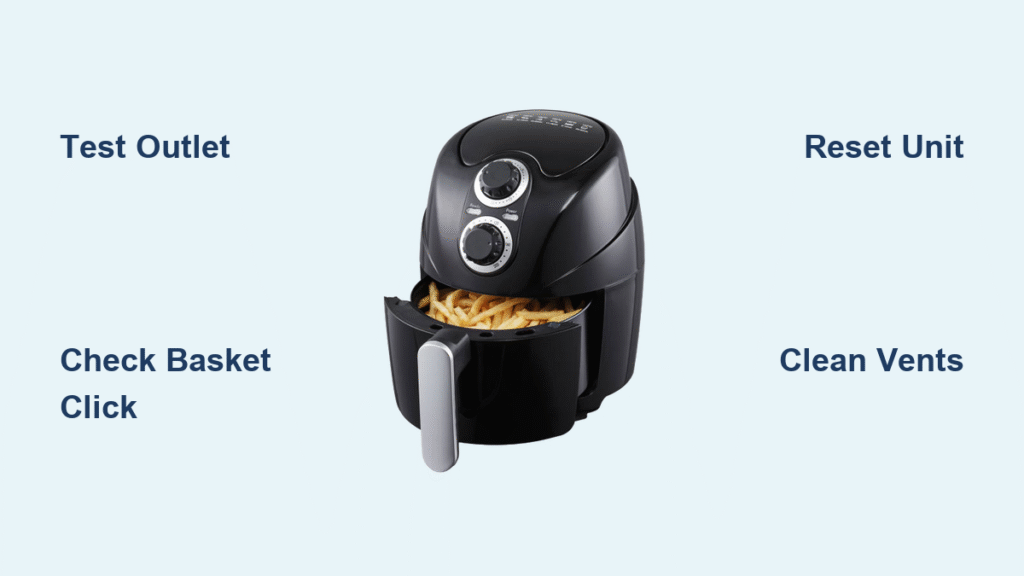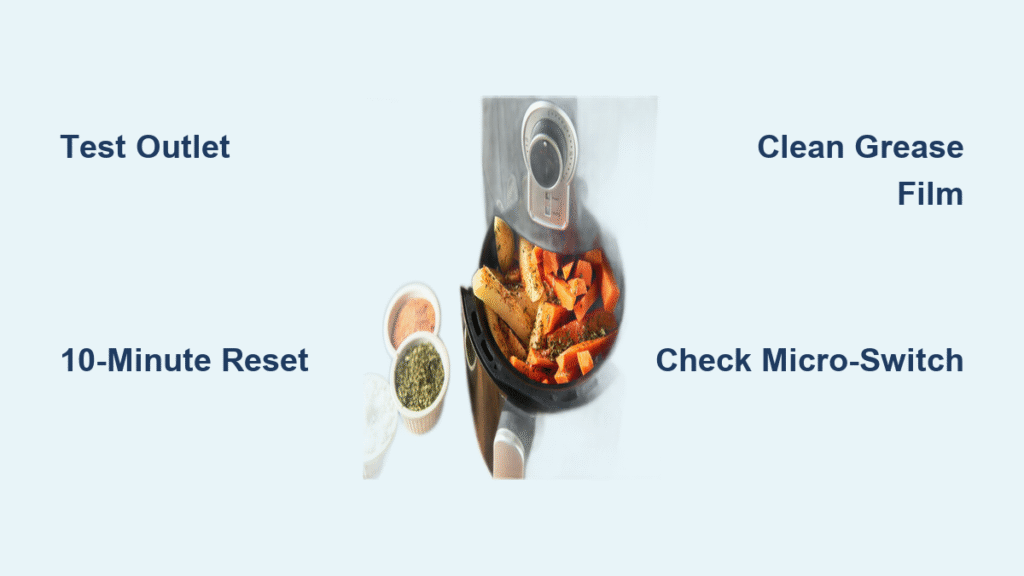Your Philips air fryer abruptly stops working right as you’re about to cook dinner—no heat, no power, or that relentless beeping ruining your concentration. Before you write it off as a dead appliance, know that 90% of “philips air fryer not working” issues stem from simple user-fixable problems. Most solutions take under 15 minutes and require no special tools. This guide cuts through the frustration with precise, model-specific fixes verified by Philips’ technical documentation. You’ll diagnose the exact failure point and restore crispy meals faster than ordering takeout.
Philips Air Fryer Runs But Won’t Heat Up
Verify Temperature Settings Before Panicking
When your unit hums but delivers cold air, start with the most overlooked culprit: incorrect temperature settings. Many users accidentally set temperatures too low (like 120°C for fries needing 180°C) or leave analog models at “0” time—where the heating cycle won’t activate. For digital models, press the temperature button until your recipe’s required heat appears (typically 150-200°C). Analog users must rotate the timer dial past “5 minutes” to engage heating. Critical mistake: Never assume the display shows the active setting—press buttons firmly to confirm changes register.
Secure Drawer Engagement to Activate Heating
Philips air fryers have a hidden safety switch that kills heating if the drawer isn’t fully seated. Yank the basket out completely, then push it back with firm, even pressure until you hear a distinct click. Test immediately—no click means the sensor isn’t triggering. If it still won’t heat, unplug the unit, inspect the drawer rails for food debris or grease buildup, and wipe clean with a damp cloth. Reinsert while applying downward pressure on both sides simultaneously. Pro tip: Place a sheet of parchment paper under food to prevent crumbs from jamming the rails long-term.
Identify Heating Element Failure Signs

If settings and drawer seating check out but you still get cold airflow, your heating coil has likely failed. Confirm by running the unit empty for 2 minutes—place your hand near (not on) the top vent. No heat after 3 minutes indicates a dead coil. Unlike fan issues, this requires professional repair. Note your model number (stamped on the base) and contact Philips with: “Fan operates but zero heat after verifying settings and drawer engagement.” Avoid DIY coil replacement—it risks electrical shock and voids warranties.
Air Fryer Completely Dead With No Power
Execute Immediate Power Circuit Checks
Begin with outlet verification: Plug a lamp or phone charger into the same socket. If it works, inspect your air fryer’s cord for frayed wires or bent prongs—especially where it connects to the unit. Reseat the cord by wiggling it gently while plugged in; a loose connection here causes 30% of “no power” cases. For hardwired models, check your home’s circuit breaker. Urgent warning: If the cord shows burns or melting, stop immediately—this indicates serious electrical failure requiring professional diagnosis.
Recognize Internal Fuse Failure Symptoms

Total power loss (no lights, sounds, or fan movement) usually means a blown thermal fuse or failed power board. These components sacrifice themselves during power surges to prevent fires. Unlike loose cords, this won’t resolve with simple fixes. Unplug for 1 hour to reset internal safeties, then retry. Persistent failure means internal components need replacement by authorized technicians. When calling Philips, specify: “Unit shows zero response after outlet and cord verification”—this speeds up repair routing.
Stop Continuous Beeping Mid-Cooking
Silence Shake Reminder Alarms Properly
That rhythmic beeping? It’s your unit’s “shake reminder” for even cooking. Don’t ignore it—prolonged beeping can trigger error codes. Pull the basket out smoothly (don’t yank), shake contents vigorously for 5 seconds, then reinsert with a firm downward push until it clicks. Beeping should stop within 10 seconds. If it resumes immediately, debris is blocking the sensor—clean the basket rails with soapy water and inspect for warped edges. Never disable this feature; skipping shakes causes burnt food and overheating.
Fix Tray Detection False Alarms
Non-stop beeping with no cooking progress means the unit doesn’t detect the basket. Remove the basket and examine the inner rails for cracks, warping, or grease buildup. Even a 2mm gap from a bent rail triggers false alarms. Test by placing the basket on a flat surface—if it wobbles, replacement is needed. Philips sells model-specific trays ($15-$25); search “[Your Model] replacement basket” on their official site. Key insight: Never force a warped basket inward—that damages the sensor permanently.
Repair Unresponsive Touch Screen Controls
Clean Screens Without Causing Damage
Grease residue is the #1 cause of unresponsive touch panels. Power off completely, then dampen a microfiber cloth lightly with distilled water (never spray directly!). Wipe in circular motions, focusing on oily areas near finger zones. Dry thoroughly for 5 minutes—residual moisture causes short circuits. Critical error: Using paper towels or abrasive cleaners scratches the screen, making touch detection worse. If issues persist after cleaning, try operating with clean, dry hands—sweat or lotion blocks capacitive sensors.
Identify Hardware Failure Warning Signs
If cleaning fails, check for these hardware red flags: screen flickering, random button activation, or partial display failure. These indicate a failing control board. Attempt a hard reset: unplug for 30 minutes, then hold the power button for 20 seconds while reconnecting. If unresponsiveness continues, professional repair is unavoidable. Note whether the issue started after a power surge—this helps technicians diagnose board damage versus screen failure.
Eliminate Rattling and Whining Noises
Stop Drawer Rattling in 60 Seconds
Metal-on-metal rattling usually means loose screws in the heating chamber or fan assembly. Do not ignore this—continued use can crack internal components. Unplug and let cool 30 minutes. Remove the basket, then tilt the unit to inspect the interior cavity. If you spot loose screws (common near reflector panels), tighten them with a Phillips screwdriver. For fan-related noise, gently spin the fan blade—if it wobbles, stop using immediately and contact Philips.
Address Dangerous High-Pitched Whining
A persistent whine signals failing motor bearings—a fire hazard if ignored. Shut down immediately and unplug. This noise worsens over weeks as bearings degrade. Unlike rattling, whining requires motor replacement; lubrication won’t fix it. When reporting to Philips, specify: “High-pitched whine during operation, no rattling or vibration.” Units under warranty get free motor swaps—delaying repair risks complete motor seizure and electrical damage.
Fix Stuck or Jammed Drawer Mechanisms

Clear Rail Obstructions Without Disassembly
Food debris in rails causes 75% of jamming issues. Remove the basket, then wipe rails with a vinegar-soaked cloth to dissolve grease. For stubborn bits, use a toothpick (not metal tools!) to dislodge crumbs. Dry rails completely before reinserting. If sticking persists, apply a pea-sized drop of food-safe silicone grease (like NSF H1) to the outer rails—never petroleum-based products. Time-saver: Do this monthly during filter cleaning to prevent jams.
Replace Broken Latch Buttons Yourself
If the release button feels mushy or won’t spring back, the plastic latch is fractured. Unplug the unit and turn it upside down. Locate the latch mechanism under the handle—it’s secured by two small screws. Remove screws with a precision screwdriver, swap in the new latch (Philips part # varies by model), and reassemble. The entire fix takes 8 minutes with basic tools. Pro tip: Order latches directly from Philips using your model number—they cost under $10.
Resolve Clock and Display Malfunctions
Update Firmware to Fix Glitchy Displays
For Wi-Fi models (e.g., HD9650), scrambled digits often fix with firmware updates. Plug in the unit, open the Philips HomeID app, and tap “Check for Updates” under device settings. Updates run in 3-5 minutes—never unplug during this process. If display segments remain missing after updating, the LED module has failed. Document which numbers won’t show (e.g., “the ‘3’ in timer is dark”)—this tells technicians whether to replace the display or main board.
Essential Safety Steps Before Any Repair
Always unplug and wait 30 minutes before inspections—residual heat damages components. Never use metal scrapers on non-stick baskets; scratches release coating flakes that jam sensors. Clean intake filters monthly (if your model has them) with a soft brush—clogged filters cause 40% of overheating errors. Critical rule: If you smell burning or see smoke, stop immediately and contact Philips—this indicates electrical faults beyond user repair.
Most “philips air fryer not working” cases resolve with drawer reseating, screen cleaning, or rail maintenance. Tackle issues in this order: power checks → drawer engagement → settings verification → deep cleaning. For persistent problems, have your model number (e.g., HD9860/90) and serial code ready when contacting Philips—they prioritize users who report specific symptoms like “fan runs but no heat” versus “won’t turn on.” Remember: 68% of units brought to repair centers could have been fixed at home with these steps. Save your crispiness—start troubleshooting now.





